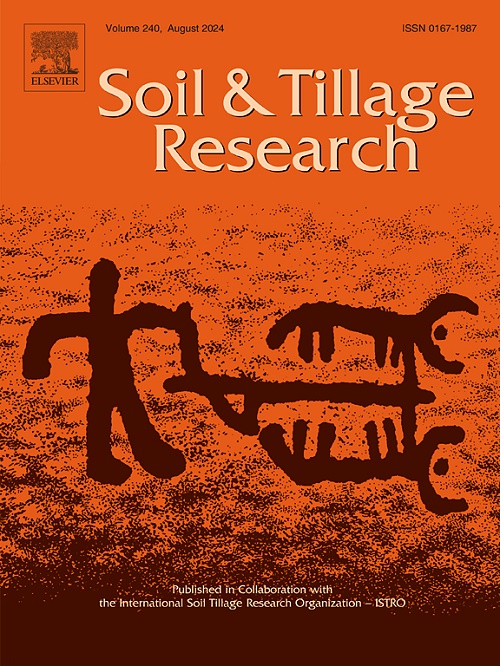通过搅拌和萃取改性,提高了土壤中阳离子交换容量和交换性碱性阳离子的测定效率
IF 6.1
1区 农林科学
Q1 SOIL SCIENCE
引用次数: 0
摘要
六氨合氯化钴([Co(NH3)6]Cl3)法提取可交换(exch.)对于含有碳酸钙的土壤,可使用方解石饱和的 [Co(NH3)6]Cl3 溶液来测定交换性碱阳离子。钙。方解石饱和 [Co(NH3)6]Cl3 溶液的配制时间需要过夜。本研究评估了使用搅拌改良法制备 [Co(NH3)6]Cl3 溶液的等效性。该改良方法大大节省了时间,整个萃取时间可缩短至 3-5 分钟。在测量含有碳酸钙的土壤时,可以省略制备方解石饱和[Co(NH3)6]Cl3 溶液的步骤。对于酸性土壤,所测得的 CEC 值低于认证范围,exch.Ca、Na 和 K 均在认证值范围内;exch.镁高于认证范围。对于神经性土壤,测得的 CEC、exch.钙、镁、钠和钾均在认证值范围内。对于碱性土壤,测得的 CEC 值高于认证值范围,exch.钙、镁、钠和钾均在认证范围内。对于盐碱土,测得的 CEC 值高于认证范围,钙、镁、钠和钾的交换量低于认证范围。镁和钾的交换量低于认证范围;精确的钙和钠交换量即使在盐碱地中也无法实现。由于石膏和钠盐的溶解,即使在如此短的提取时间内也无法实现 Ca 和 Na 的准确交换。对于含钠土壤,测得的 CEC 值高于认证范围,exch.镁和钾低于认证范围;萃取的钙可以认为是 exch.Ca;exch.Na 可按 CEC-(exch.Ca+exch.Mg+exch.K)计算。测量值与认证值之间的 CEC 差异主要是由于萃取剂 pH 值的差异造成的。添加 CaCO3(≤ 80%)对 CEC 或碱式阳离子交换值的测定没有影响。CaCO3 和 CaSO4∙2 H2O 的组合仅影响 exch.Ca本文章由计算机程序翻译,如有差异,请以英文原文为准。
Improved determination efficiency of the cation exchange capacity and exchangeable base cations in soil using stirring and extraction modifications
The hexamminecobalt trichloride ([Co(NH3)6]Cl3) method extracts exchangeable (exch.) base cations needing 60 min. For soils containing calcium carbonate, a calcite saturated [Co(NH3)6]Cl3 solution is used to determine the exch. Ca. The preparing time of calcite saturated [Co(NH3)6]Cl3 solution requires to set overnight. This study evaluated the equivalence of [Co(NH3)6]Cl3 method using stirring modification. The proposed modification can vastly save time and the whole extraction time can be shortened to 3–5 min. The preparing calcite saturated [Co(NH3)6]Cl3 solution procedure can be omitted when measured soils containing calcium carbonate. For acidic soil, the measured CEC was below the certified range, the exch. Ca, Na and K were all in the certified value range; the exch. Mg above the certified range. For neural soil, the measured CEC, exch. Ca, Mg, Na and K were all in the certified range. For alkaline soil, the measured CEC was above the certified range, the exch. Ca, Mg, Na and K were all in the certified range. For saline soil, the measured CEC was above the certified range, the exch. Mg and K below the certified range; accurate exch. Ca and Na could not be achieved even in such a short extraction time because of the dissolution of gypsum and sodium salts. For sodic soil, the measured CEC was above the certified range, the exch. Mg and K below the certified range; the extracted Ca can be assumed the exch. Ca; the exch. Na can be calculated as CEC-(exch. Ca + exch. Mg + exch. K). The difference of CEC between measured and certified values were mainly because of the discrepancy of extractant pHs. The addition of CaCO3 (≤ 80 %) had no effect on CEC or exch. base cations’ determinations. The CaCO3 and CaSO4∙2 H2O combination only affected the determination of exch. Ca.
求助全文
通过发布文献求助,成功后即可免费获取论文全文。
去求助
来源期刊

Soil & Tillage Research
农林科学-土壤科学
CiteScore
13.00
自引率
6.20%
发文量
266
审稿时长
5 months
期刊介绍:
Soil & Tillage Research examines the physical, chemical and biological changes in the soil caused by tillage and field traffic. Manuscripts will be considered on aspects of soil science, physics, technology, mechanization and applied engineering for a sustainable balance among productivity, environmental quality and profitability. The following are examples of suitable topics within the scope of the journal of Soil and Tillage Research:
The agricultural and biosystems engineering associated with tillage (including no-tillage, reduced-tillage and direct drilling), irrigation and drainage, crops and crop rotations, fertilization, rehabilitation of mine spoils and processes used to modify soils. Soil change effects on establishment and yield of crops, growth of plants and roots, structure and erosion of soil, cycling of carbon and nutrients, greenhouse gas emissions, leaching, runoff and other processes that affect environmental quality. Characterization or modeling of tillage and field traffic responses, soil, climate, or topographic effects, soil deformation processes, tillage tools, traction devices, energy requirements, economics, surface and subsurface water quality effects, tillage effects on weed, pest and disease control, and their interactions.
 求助内容:
求助内容: 应助结果提醒方式:
应助结果提醒方式:


